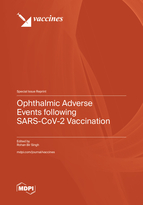Ophthalmic Adverse Events following SARS-CoV-2 Vaccination
A special issue of Vaccines (ISSN 2076-393X). This special issue belongs to the section "COVID-19 Vaccines and Vaccination".
Deadline for manuscript submissions: closed (31 December 2023) | Viewed by 35603
Special Issue Editor
2. Department of Ophthalmology, Leiden University Medical Center, Leiden, The Netherlands
3. Discipline of Ophthalmology and Visual Sciences, Faculty of Health and Medical Sciences, Adelaide Medical School, University of Adelaide, Adelaide, Australia
Interests: cornea; dry eye disease; corneal transplantation; corneal regeneration; epidemiology
Special Issues, Collections and Topics in MDPI journals
Special Issue Information
Dear Colleagues,
In December 2020, the largest global vaccination efforts were launched to limit the spread and clinical severity of SARS-CoV-2. Although the vaccines have been reported to be highly efficacious in limiting the impact of SARS-CoV-2, their swift development and emergency use authorizations limited the short and long-term evaluation of rare adverse events in real-world settings. Over the past 20 months, several reports and studies have highlighted the adverse events (such as myocarditis, Guillain–Barré syndrome, etc.) following the administration of these vaccines. In this special edition, we are compiling case reports, series, review articles and studies focused on ophthalmic adverse events following SARS-CoV-2 vaccinations.
The submissions may include:
- Case of rare ophthalmic adverse events following vaccination
- Studies reporting risk of ophthalmic adverse events following vaccine
- Analysis of global databases reporting vaccine-associated ophthalmic adverse events
- Review articles evaluating published literature on ocular adverse events with special emphasis on underlying potential mechanisms.
Dr. Rohan Bir Singh
Guest Editor
Manuscript Submission Information
Manuscripts should be submitted online at www.mdpi.com by registering and logging in to this website. Once you are registered, click here to go to the submission form. Manuscripts can be submitted until the deadline. All submissions that pass pre-check are peer-reviewed. Accepted papers will be published continuously in the journal (as soon as accepted) and will be listed together on the special issue website. Research articles, review articles as well as short communications are invited. For planned papers, a title and short abstract (about 100 words) can be sent to the Editorial Office for announcement on this website.
Submitted manuscripts should not have been published previously, nor be under consideration for publication elsewhere (except conference proceedings papers). All manuscripts are thoroughly refereed through a single-blind peer-review process. A guide for authors and other relevant information for submission of manuscripts is available on the Instructions for Authors page. Vaccines is an international peer-reviewed open access monthly journal published by MDPI.
Please visit the Instructions for Authors page before submitting a manuscript. The Article Processing Charge (APC) for publication in this open access journal is 2700 CHF (Swiss Francs). Submitted papers should be well formatted and use good English. Authors may use MDPI's English editing service prior to publication or during author revisions.
Keywords
- vaccination
- SARS-CoV-2
- ophthalmic adverse events
- adverse events
- COVID-19 vaccination







